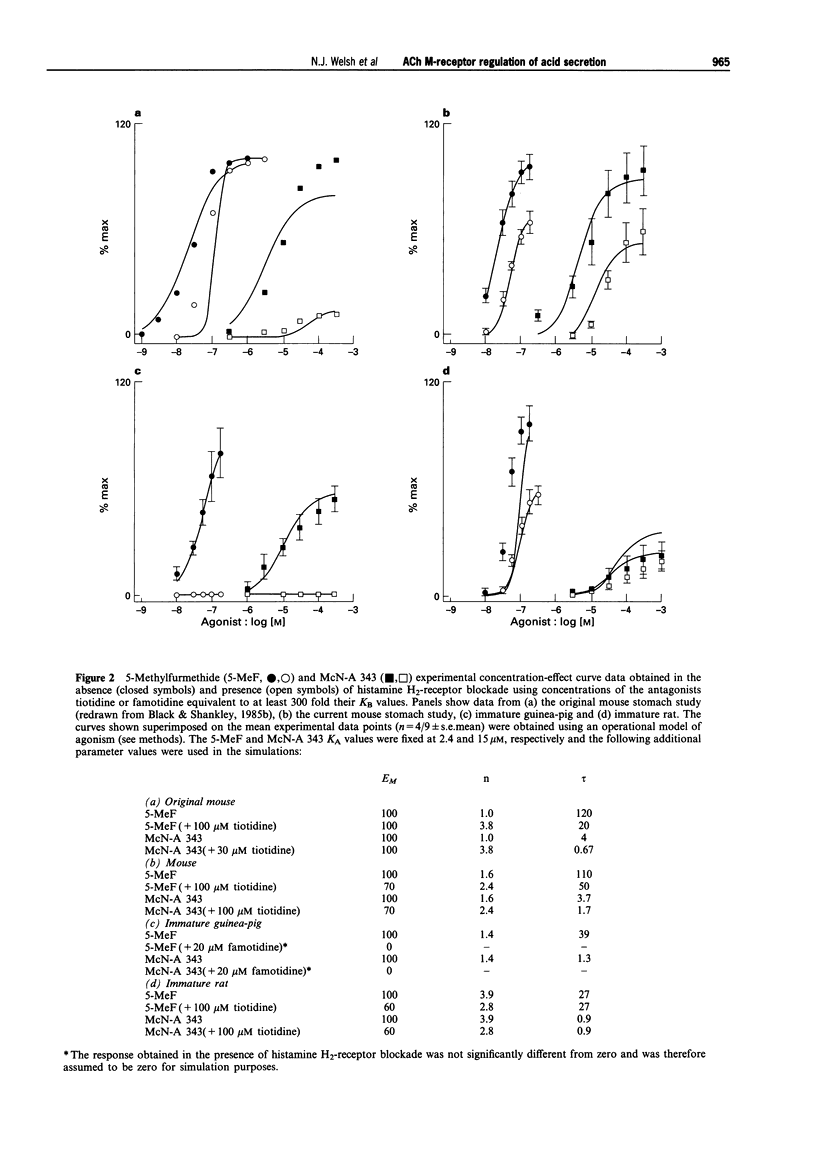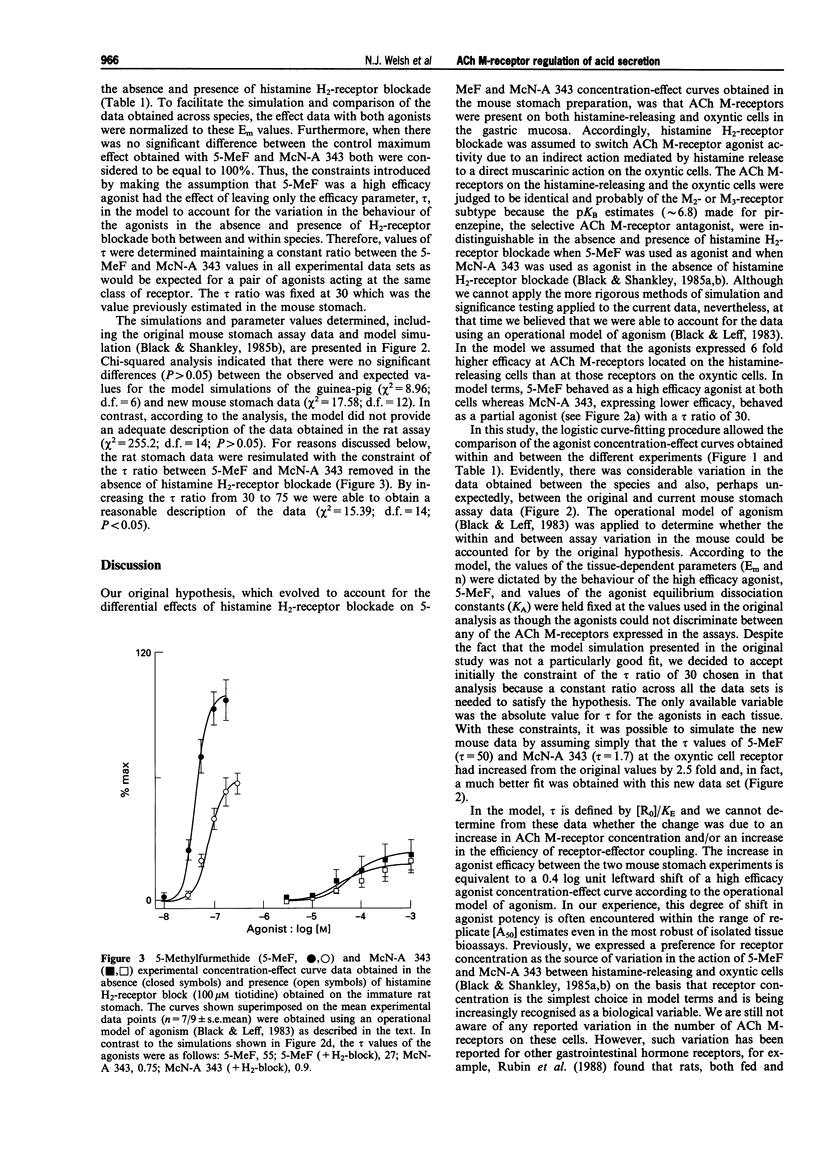Abstract
1. Concentration-effect curves were obtained, in the absence and presence of histamine H2-receptor blockade, to 5-methylfurmethide (5-MeF) and McN-A 343, high efficacy and low efficacy acetylcholine (ACh) M-receptor agonists, respectively, in isolated stomach preparations from the mouse and immature rat and guinea-pig. 2. In the immature guinea-pig assay, the responses to 5-MeF and McN-A 343 were abolished by histamine H2-receptor blockade suggesting that the responses were totally dependent upon gastric mucosal histamine. However, in the mouse and immature rat assays, although the histamine H2-receptor antagonists produced small but significant rightward shifts and, in some cases, depression of the maximum of the agonist concentration-effect curves, a significant secretory response remained, presumed to be due to direct stimulation of oxyntic cells. 3. Previously, by assuming that the histamine H2-receptor blockade alters the mode of agonist-stimulated acid secretion from mainly an indirect action mediated by histamine release to direct stimulation of the oxyntic cell, we applied an operational model of agonism to similar data obtained in the mouse preparation. In that study we were able to account for the behaviour of 5-MeF and McN-A 343 by assuming that the agonists expressed 6 fold higher efficacy, tau in the operational model of agonism, at ACh M-receptors on the histamine-releasing cells than on the oxyntic cells. In this study it was possible to account for the variation in the behaviour of the agonists both between and within assays by simply varying the efficacy expressed by the agonists at each of the cells in the model.(ABSTRACT TRUNCATED AT 250 WORDS)
Full text
PDF







Selected References
These references are in PubMed. This may not be the complete list of references from this article.
- Bishop L. A., Gerskowitch V. P., Hull R. A., Shankley N. P., Black J. W. Combined dose-ratio analysis of cholecystokinin receptor antagonists, devazepide, lorglumide and loxiglumide in the guinea-pig gall bladder. Br J Pharmacol. 1992 May;106(1):61–66. doi: 10.1111/j.1476-5381.1992.tb14293.x. [DOI] [PMC free article] [PubMed] [Google Scholar]
- Black J. W., Leff P. Operational models of pharmacological agonism. Proc R Soc Lond B Biol Sci. 1983 Dec 22;220(1219):141–162. doi: 10.1098/rspb.1983.0093. [DOI] [PubMed] [Google Scholar]
- Black J. W., Leff P., Shankley N. P. Further analysis of anomalous pKB values for histamine H2-receptor antagonists on the mouse isolated stomach assay. Br J Pharmacol. 1985 Nov;86(3):581–587. doi: 10.1111/j.1476-5381.1985.tb08934.x. [DOI] [PMC free article] [PubMed] [Google Scholar]
- Black J. W., Leff P., Shankley N. P. Further analysis of anomalous pKB values for histamine H2-receptor antagonists on the mouse isolated stomach assay. Br J Pharmacol. 1985 Nov;86(3):581–587. doi: 10.1111/j.1476-5381.1985.tb08934.x. [DOI] [PMC free article] [PubMed] [Google Scholar]
- Black J. W., Leff P., Shankley N. P., Wood J. An operational model of pharmacological agonism: the effect of E/[A] curve shape on agonist dissociation constant estimation. Br J Pharmacol. 1985 Feb;84(2):561–571. doi: 10.1111/j.1476-5381.1985.tb12941.x. [DOI] [PMC free article] [PubMed] [Google Scholar]
- Black J. W., Shankley N. P. Pharmacological analysis of muscarinic receptors coupled to oxyntic cell secretion in the mouse stomach. Br J Pharmacol. 1985 Nov;86(3):601–607. doi: 10.1111/j.1476-5381.1985.tb08936.x. [DOI] [PMC free article] [PubMed] [Google Scholar]
- Black J. W., Shankley N. P. Pharmacological analysis of the inhibition by pirenzepine and atropine of vagal-stimulated acid secretion in the isolated stomach of the mouse. Br J Pharmacol. 1986 May;88(1):291–297. doi: 10.1111/j.1476-5381.1986.tb09498.x. [DOI] [PMC free article] [PubMed] [Google Scholar]
- Black J. W., Shankley N. P. Pharmacological analysis of the muscarinic receptors involved when McN-A 343 stimulates acid secretion in the mouse isolated stomach. Br J Pharmacol. 1985 Nov;86(3):609–617. doi: 10.1111/j.1476-5381.1985.tb08937.x. [DOI] [PMC free article] [PubMed] [Google Scholar]
- Black J. W., Shankley N. P. The isolated stomach preparation of the mouse: a physiological unit for pharmacological analysis. Br J Pharmacol. 1985 Nov;86(3):571–579. doi: 10.1111/j.1476-5381.1985.tb08933.x. [DOI] [PMC free article] [PubMed] [Google Scholar]
- Eglen R. M., Kenny B. A., Michel A. D., Whiting R. L. Muscarinic activity of McN-A-343 and its value in muscarinic receptor classification. Br J Pharmacol. 1987 Apr;90(4):693–700. doi: 10.1111/j.1476-5381.1987.tb11222.x. [DOI] [PMC free article] [PubMed] [Google Scholar]
- Grossman M. I., Konturek S. J. Inhibition of acid secretion in dog by metiamide, a histamine antagonist acting on H2 receptors. Gastroenterology. 1974 Apr;66(4):517–521. [PubMed] [Google Scholar]
- Leff P., Martin G. R., Morse J. M. Application of the operational model of agonism to establish conditions when functional antagonism may be used to estimate agonist dissociation constants. Br J Pharmacol. 1985 Jul;85(3):655–663. doi: 10.1111/j.1476-5381.1985.tb10561.x. [DOI] [PMC free article] [PubMed] [Google Scholar]
- Rubin N. H., Singh P., Alinder G., Greeley G. H., Jr, Rayford P. L., Rietveld W. J., Thompson J. C. Circadian rhythms in gastrin receptors in rat fundic stomach. Dig Dis Sci. 1988 Aug;33(8):931–937. doi: 10.1007/BF01535987. [DOI] [PubMed] [Google Scholar]
- Shankley N. P., Welsh N. J., Black J. W. Histamine dependence of pentagastrin-stimulated gastric acid secretion in rats. Yale J Biol Med. 1992 Nov-Dec;65(6):613–619. [PMC free article] [PubMed] [Google Scholar]
- Soll A. H. The interaction of histamine with gastrin and carbamylcholine on oxygen uptake by isolated mammalian parietal cells. J Clin Invest. 1978 Feb;61(2):381–389. doi: 10.1172/JCI108948. [DOI] [PMC free article] [PubMed] [Google Scholar]
- Waud D. R., Parker R. B. Pharmacological estimation of drug-receptor dissociation constants. Statistical evaluation. II. Competitive antagonists. J Pharmacol Exp Ther. 1971 Apr;177(1):13–24. [PubMed] [Google Scholar]
- Welsh N. J., Shankley N. P., Black J. W. Comparative analysis of the vagal stimulation of gastric acid secretion in rodent isolated stomach preparations. Br J Pharmacol. 1994 May;112(1):93–96. doi: 10.1111/j.1476-5381.1994.tb13035.x. [DOI] [PMC free article] [PubMed] [Google Scholar]


